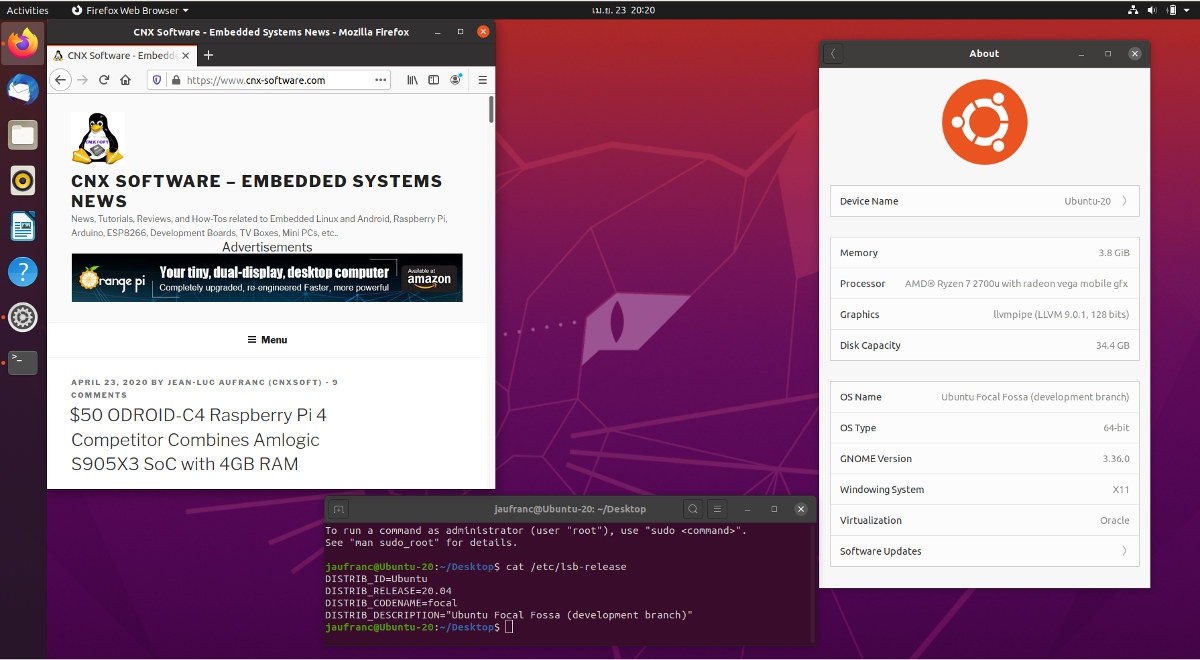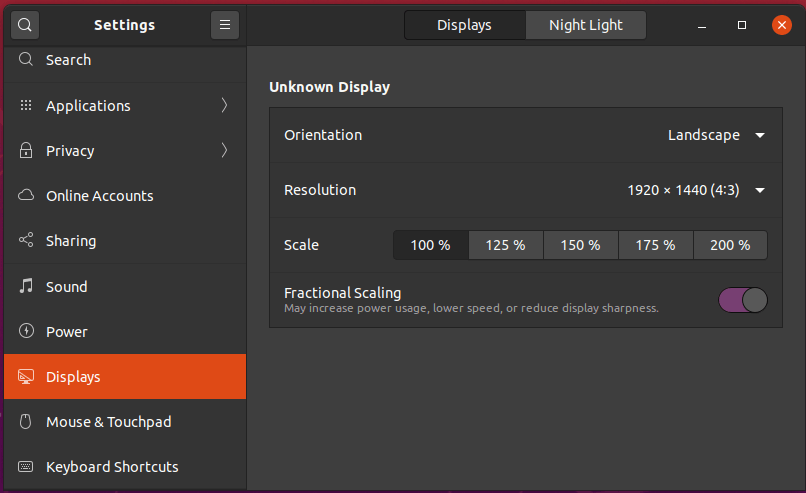Ubuntu 18.04 “Bionic Beaver” was released nearly exactly two years ago, and that means it’s time for another LTS (Long Term Support) release with Canonical officially releasing Ubuntu 20.04 “Focal Fossa” today.
There are a few changes to the graphical user interface, Amazon Icon is now gone, a recent Linux 5.4 kernel is used by default with Wireguard VPN backport, and snap becomes a first citizen in Ubuntu 20.04. This is also the first LTS version of Ubuntu that does not provide 32-bit x86 images.

Ubuntu 20.04 ISO files will soon be found on Ubuntu website, and if you already a machine with Ubuntu 18.04 or 19.10, you should be able to upgrade with the following commands:
|
1 2 3 4 |
sudo apt update sudo apt dist-upgrade sudo apt install update-manager-core sudo do-release-upgrade |
It’s possible the release has not been pushed to your mirror, so you may need to wait for a little while, or use the command to install the development release :
|
1 |
sudo do-release-upgrade -d |
[Update: If you are running Ubuntu 18.04.x LTS, do-release-update will only work after 20.04.1 release in July 2020, so you need to run the command above to install it before July 2020]
Let’s go through some of the most noticeable graphical changes first.
The Settings menu now allows the user to change the Appearance to a Light and Dark theme.
Fractional Scaling is now a Display option, which may be good for higher resolution displays (e.g. 4K), but may increase power usage, lower speed, or reduce display sharpness.
Toggle the new “Do Not Disturb” button in Ubuntu 20.04 may be a good idea to stop notifications from showing up, and improve your productivity.
Canonical first introduced Snap as far back as 2015, but until now most people likely still used apt to install apps. There are changes in Ubuntu 20.04 with the Snap Store (snap-store) replacing ubuntu-software as the default tool for finding and installing packages and snaps.

If you try to run a command that is not installed it will recommend the snap command before the apt command. At least that’s in theory because it does not work for me.
I tried several commands and same results. My Internet connection is pretty poor those days, so maybe something failed to download…
Ubuntu 20.04 also updated several packages:
- Toolchains – glibc 2.31, OpenJDK 11, rustc 1.41, GCC 9.3, Python 3.8.2, ruby 2.7.0, php 7.4, perl 5.30, golang 1.13. Note that Python 2.7 has been moved to universe and is not included by default in any new installs.
- GNOME 3.36 with a new design, smoother performance, and lower CPU usage
-
Firefox 75.0, Thunderbird 68.7.0, LibreOffice 6.4
You’ll find a longer list of changes in the release notes.

Jean-Luc started CNX Software in 2010 as a part-time endeavor, before quitting his job as a software engineering manager, and starting to write daily news, and reviews full time later in 2011.
Support CNX Software! Donate via cryptocurrencies, become a Patron on Patreon, or purchase goods on Amazon or Aliexpress









Before zooming on the text I thought I read “fecal fossa” which I found a rather strange name for a distro!
I switched to daily builds of 20.04 LTS Mate early march for use on a Threadripper 3rd generation motherboard ASUS ROG Zenith II Extreme TRX40. Issue with 18.04 LTS was described by Phoronix, workaround did not work for me, I’m no expert in Kernel drivers and entrails. Manjaro 18.1.5 also worked fine on the TRX40, but I’m so used to CentOS and Ubuntu Mate that I wanted to avoid yet another distribution to the set I’m using. Regular workstation usage, development, Cassandra, web, mobile, Python, etc. Using ext4, not ZFS. 20.04 LTS Mate has been working AOK so far. Happy.… Read more »
“This is also the first version of Ubuntu that does not provide 32-bit x86 images.”
Incorrect – Ubuntu 18.04 did not provide 32-bit x86 images either (ISOs – it still provided cloud images and deb packages).
Ubuntu 19.10 was actually the first to completely remove x86 (32bit) support.
So 20.04 would be the second release (and first LTS ) to remove 32bit packages
That’s not entirely correct either. What they removed is the majority of 32 bit packages, what remains is the core 32 bit library support for multilib under x64 in order to support Steam and the vast majority of commercial games out there.
Hey,
what is the Fonts name which is visible in your screenshots?
Not quite sure. I did not change the settings, so it must be the default Ubuntu font, at least the default one while using English with Thai locale.
Thank You 😉
In your command list #3 should be this :
$ update-manager -d
With a note to run Software Updater beforehand, then exit and reboot if things were updated, on new terminal run above cmd and it will find 20.04 if you are on 18.04 without having to input $do-releases-upgrade
I’m not sure how you numbered the commands. From a 19.10 system, I tried the commands from the article and was told that there wasn’t a new release in the repo. I didn’t try -d since I didn’t want to get on some testing track.
I don’t normally use Ubuntu but Nvidia horrors forced that on me for one notebook. The new Fractional Scaling would make its UltraHD screen more useful.
Ubuntu 19.10’s support for the proprietary Nvidia drive is quite slick, unlike Fedora’s. For ethical other reasons I normally prefer Fedora.
Thanks for the hint. In my case I needed to run:
$ sudo do-release-upgrade -d
not do-release-update. Maybe a typo?